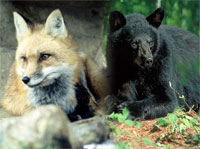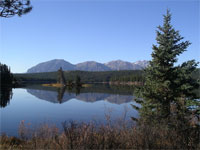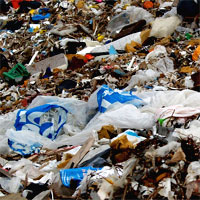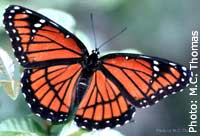
News |
- Climate Bill C-311 Moves to Final Vote
- Manitoba Egg Farmers Support "Five Freedoms"
- Federal EA for East Side Road Starts
- Mercury Killing Grassy Narrows Citizens
- First Nations Take Oil Sands to Supreme Court
- Bears and Foxes Die in Oil Sands
- Clean Air Rules Set for Ships
- U.N. Meeting Rejects Shark Protections
- Oil Sands Report Card Gives Poor Grades
- B.C. Lake to Become Tailings Pond
- Manitoba Plastic Bags Now Regulated
- Butterflies, Beetles, Dragonflies Decline in Europe
| Climate Bill C-311 Moves to Final Vote | 21 April 10 |
 The Canadian House of Commons Bill C-311, entitled An Act to ensure Canada assumes its responsibilities in preventing dangerous climate change passed second vote April 14, 2020. The Bill requires the Canadian government to set regulations to bring emissions 25% below 1990 levels by 2020, with a long-term target to bring emissions 80% below 1990 levels by 2050. The Bill moves to a third reading and a vote to adopt the Bill May 5th, 2010. The bill previously passed third reading in House of Commons in 2008 but did not have its Senate vote and died because of the election call. The Canadian House of Commons Bill C-311, entitled An Act to ensure Canada assumes its responsibilities in preventing dangerous climate change passed second vote April 14, 2020. The Bill requires the Canadian government to set regulations to bring emissions 25% below 1990 levels by 2020, with a long-term target to bring emissions 80% below 1990 levels by 2050. The Bill moves to a third reading and a vote to adopt the Bill May 5th, 2010. The bill previously passed third reading in House of Commons in 2008 but did not have its Senate vote and died because of the election call."After years of the government backsliding on climate change it is refreshing to see political parties reuniting on this critical issue," said John Bennett, Executive Director of Sierra Club Canada. "The government must now heed the will of the House and the Canadian people, it is time to put this bill into law." "We can't afford to put global warming aside anymore, we need real action to curb climate change in Canada," said Bennett. "This bill should have been passed years ago, now we have to get moving on concrete measures to put this bill into practice." In addition to Bill C-311, the Liberal Official Opposition tabled a motion calling on the government to take immediate and decisive action on the environment and climate change. The motion called on the Conservative government to set legally binding, long term emission reduction targets, and implement a national climate change plan with economy-wide regulations. View Bill C-311View Sierra Club Statement View April 13, 2010 Liberal Party press release View April 14, 2010 Climate Action Network Canada press release View April 15, 2010 Youth Climate Movement article Source: Government of Canada, Sierra Club, Climate Action Network Canada |
|
 Print version Print version |
Top |
| Manitoba Egg Farmers Support "Five Freedoms" | 21 April 10 |
 The Manitoba Egg Farmers have stated their intention to create a new policy that mandates any new or renovated hen housing after 2018 to follow the "five freedoms" standard. The Manitoba Egg Farmers have stated their intention to create a new policy that mandates any new or renovated hen housing after 2018 to follow the "five freedoms" standard.The "five freedoms" model states that food animals are entitled to freedom from thirst, hunger and malnutrition; freedom from discomfort; freedom from pain, injury and disease; freedom to express normal behaviour; and freedom from fear and distress. The Manitoba Egg Farmers stated in a press release that enriched cages combine the food safety benefits of conventional cages with the welfare benefits of open housing. Such cages include "furnishings" such as perches, scratch pads and nesting areas, the group said, and enable hens to "express natural behaviours." The new policy would be binding on egg farmers who build new facilities, or undertake a major retrofit after 2018. The Manitoba Egg Farmers, representing the province's 168 regulated egg and pullet farmers, stated it recognizes "the importance of providing the public with quality food along with the reassurance that our laying hens are well looked after." View March 10, 2010 Manitoba Co-operator articleView April 13, 2010 SPCA article View Manitoba Egg Farmers website View Alberta Farm Animal Care - Five Freedoms website Source: Manitoba Co-operator |
|
 Print version Print version |
Top |
| Federal EA for East Side Road Starts | 16 April 10 |
 Environment Canada has posted a notice to start a comprehensive study under the Canadian Environment Assessment Act for the first phase of the 'East Side Road' in Manitoba. The Department of Fisheries and Oceans will conduct the assessment, as responsible agency. Environment Canada has posted a notice to start a comprehensive study under the Canadian Environment Assessment Act for the first phase of the 'East Side Road' in Manitoba. The Department of Fisheries and Oceans will conduct the assessment, as responsible agency.Manitoba Conservation and the East Side Road Authority posted the provincial environmental impacts statement for public comments in late 2009. Engineering studies are underway for future projects, for several hundred kilometers of all weather road in the region. The decision to move from a screening of this project to a comprehensive study is, according to the formal posting, "as a result of the January 21, 2010 Supreme Court of Canada ruling in MiningWatch Canada v. Canada (Minister of Fisheries and Oceans et al.), it was determined that the environmental assessment in relation to this project will be continued as a comprehensive study." Connecting First Nations communities that currently have only ice and winter road access, the 'East Side Road' phase one is a fraction of the potential future project to connect over a dozen communities to permanent all weather road services. The region is currently non roaded, intact boreal forests. Climate change has dramatically reduced winter road access for the communities. The region is also the site of a proposal for a huge new boreal world heritage site which First Nations initiated with an Accord among their communities in 2002. View Notice of Commencement of an Environmental AssessmentView Manitoba Wildlands' review comments on East Side Road Authority (PDF) View Manitoba Wildlands' information page on the East Side Road View Manitoba Wildlands' information page on Wabanong Nakaygum Okimawin View January 28, 2010 Manitoba Wildlands' news item Sources: CEAA, Environment Canada |
|
 Print version Print version |
Top |
| Mercury Killing Grassy Narrows Citizens | 14 April 10 |
 A new translation of a health study by mercury expert Dr. Harada plus recent tests show impacts from mercury poisoning in Grassy Narrows First Nation community are worse now than in the 1970's. A new translation of a health study by mercury expert Dr. Harada plus recent tests show impacts from mercury poisoning in Grassy Narrows First Nation community are worse now than in the 1970's.Dr. Harada's study found Health Canada safety mercury guidelines are too weak to protect people from long-term health impacts of low level mercury exposure, which is now worldwide due to industrial pollution from sources such as pulp mills, and coal power plants. The translated study was released on the 40th anniversary of the first fishing ban due to mercury contamination on the Wabigoon River. Between 1962 and 1970, the Dryden mill, owned by Reed Incorporated and Great Lakes Forest Products Limited, dumped 20,000 pounds of mercury into the Wabigoon River. Members of Grassy Narrows First Nation converged on Queen's Park April 7th 2010 to protest decades of mercury poisoning in their community. "We're demanding justice and action on this issue," states Grassy Narrows Chief Simon Fobister. "The people of Grassy Narrows have raised their concerns for forty years, only to have them fall on deaf ears," states Ontario Regional Chief Angus Toulouse. "The demands of Grassy Narrows First Nation are simple and achievable - it is time for the government to listen to the voices of the First Nation." View Free Grassy Narrows websiteView translation of Dr. Harada's report (PDF) View April 6, 2010 Indigenous Peoples article View April 6, 2010 CBC article View April 6, 2010 Toronto Star article View April 7, 2010 CBC article View April 7, 2010 Indigenous Peoples article Source: Indigenous Peoples, CBC |
|
 Print version Print version |
Top |
| First Nations Take Oil Sands to Supreme Court | 14 April 10 |
 The Supreme Court of Canada has granted intervenor status to Duncan's First Nation (DFN) and Horse Lake First Nation (HLFN) in a case about oil sands, pipelines, oil sands infrastructure and other major projects. The First Nations are seeking Supreme Court of Canada assistance in defending their Aboriginal and Treaty rights in the face of mounting oil sands development. The Supreme Court of Canada has granted intervenor status to Duncan's First Nation (DFN) and Horse Lake First Nation (HLFN) in a case about oil sands, pipelines, oil sands infrastructure and other major projects. The First Nations are seeking Supreme Court of Canada assistance in defending their Aboriginal and Treaty rights in the face of mounting oil sands development.DFN Chief Don Testawich stated, "Our traditional territory is being overrun and cut to pieces by oil sands, major pipelines, gas fields and major power projects. Companies projects that will fuel unsustainable oil sands growth. Development on this scale is making our Treaty Rights meaningless and threatens our traditional way of life". Chief Testawich added, "The governments of Alberta and Canada sit back and refuse to address our concerns. We are intervening before the Supreme Court because it is abundantly clear that neither the environment nor First Nations can expect to receive a fair hearing within Alberta, where oil sands revenues are at stake. We need help now and help fast". The First Nations are taking this matter to the Supreme Court because of their mounting frustration over refusal by the governments and their regulators to act on earlier court decisions that direct governments to deal with their rights. Canada's Supreme Court will hear views of First Nations, governments and industry in the Rio Tinto Alcan Inc. v. the Carrier Sekani Tribal Council case whichwill address the question of whether regulatory boards and tribunals have a duty to decide whether the Crown adequately consulted and accommodated First Nations' concerns before granting approvals for resource development. View April 9, 2010 CanadianClimateAction articleView March 12, 2010 Indigenous Peoples article View April 12, 2010 Tar Sands Watch article Source: CanadianClimateAction.com |
|
 Print version Print version |
Top |
| Bears and Foxes Die in Oil Sands | 14 April 10 |
 Documents released through a Freedom of Information request show a variety of wildlife, including dozens of black bears, deer and red foxes, were killed in Alberta oil sands developments over an eight-year period. Documents released through a Freedom of Information request show a variety of wildlife, including dozens of black bears, deer and red foxes, were killed in Alberta oil sands developments over an eight-year period.At least 164 animals were killed in the Syncrude, Suncor and Shell Canada Albian Sands, according to information given to Alberta Sustainable Resource Development. Possible reasons for death include euthanasia of problem wildlife, drowning or oiling from tailings, vehicle crashes and electrocution. The documents show 27 black bears, 31 foxes, 21 coyotes and dozens of deer were killed, along with moose, muskrats, beavers, voles, martens, wolves and bats. Environmental critics are sure the number of animals that die in oil sands incidents is much higher. "The self-policing system that allows industry to report on itself is flawed," states Mike Hudema of Greenpeace. "The Stelmach government should focus on beefing up its environmental enforcement and monitoring budget rather than putting cash into public relations campaigns." Oilsands giant Syncrude is currently on trial, charged by the federal and provincial governments, for failing to prevent waterfowl from landing on a oil sands tailings pond. View April 8, CTV articleView April 9, 2010 Calgary Herald article View April 9, 2010 Sierra Club article Source: Calgary Herald |
|
 Print version Print version |
Top |
| Clean Air Rules Set for Ships | 14 April 10 |
 The international body governing the shipping industry approved rules to limit air pollution from ships in most U.S. and Canadian waters. The rules are expected to prevent millions of illnesses and 14,000 premature deaths by 2020. The international body governing the shipping industry approved rules to limit air pollution from ships in most U.S. and Canadian waters. The rules are expected to prevent millions of illnesses and 14,000 premature deaths by 2020.The adopted rules take effect in 2012, and by 2015, will require harmful air pollution from ships in a low-pollution zone known as an Emission Control Area to decline by 80 percent or more. The law will apply to large ships such as container ships, oil tankers, and large cruise ships. The US Environmental Protection Agency (EPA) estimates that by 2030, the implementation of these limits on ship air pollution and related regulations will prevent up to 31,000 premature deaths, 1.5 million work days lost, and more than 5 million cases of acute respiratory symptoms. The health benefits could be worth $270 billion. Friends of the Earth spent ten years working to put these protections in place, beginning with a legal challenge initiated in 2000. The environmental group praised the ruling, calling it a major victory. View March 26, 2010 Friends of the Earth press releaseView March 26, 2010 Common Dreams article View March 26, 2010 Vancouver Observer article Source: Friends of the Earth |
|
 Print version Print version |
Top |
| U.N. Meeting Rejects Shark Protections | 14 April 10 |
 Reversing an earlier decision, the United Nations has rejected a proposal to regulate trade in declining stocks of sharks, dismissing protections for any of the shark species proposed under the Convention on International Trade in Endangered Species (CITES). Reversing an earlier decision, the United Nations has rejected a proposal to regulate trade in declining stocks of sharks, dismissing protections for any of the shark species proposed under the Convention on International Trade in Endangered Species (CITES).The reversal dashes hopes of protecting at least one shark breed, after nations voted earlier this week to reject protections on hammerheads, among other species. The victory is another in a long string of successes for Japan. Beyond blocking shark protections, the country successfully defeated proposed bans on bluefin tuna and protections on several species of coral. "Japan clearly mobilized massive efforts to keep fisheries out of CITES," said Mark W. Roberts, senior counsel and policy adviser for the watchdog group Environmental Investigation Agency. Canada voted with Japan at the CITES meeting. View CITES websiteView March 26, 2010 Earth News article View March 23, 2010 New York Times article View March 16, 2010 Earth News article Source: EarthPortal |
|
 Print version Print version |
Top |
| Oil Sands Report Card Gives Poor Grades | 7 April 10 |
 The Pembina Institute graded 9 facilities in Athabasca, Peace River, and Cold Lake regions, in their new report Deeper Drilling: The In Situ Oil Sands Report Card. This is the first comparative environmental assessment of in-situ oil sands projects. The average grade among the sites was poor at only 44%. The Pembina Institute graded 9 facilities in Athabasca, Peace River, and Cold Lake regions, in their new report Deeper Drilling: The In Situ Oil Sands Report Card. This is the first comparative environmental assessment of in-situ oil sands projects. The average grade among the sites was poor at only 44%.Deeper Drilling compares projects on 17 environmental indicators in five categories: general environmental management, land, air, emissions, water and climate change. The highest scoring site had a grade of 60% and the lowest 25%. The 44% average indicates that Canada's regulatory standards for in-situ oil sands extraction are set too low and need improvement. Recommendations for improvement include: implementing industry best practices, evaluating cumulative impacts, setting reduction targets for greenhouse gas emissions and water use, and investing in biodiversity offsets to compensate for terrestrial lands used. View The Pembina Institute Oil Sands Watch websiteView March 2010 The Pembina Institute Report: Deeper Drilling: The In-Situ Oil Sands Report Card (PDF) View March 2010 The Pembina Deeper Drilling Fact Sheet (PDF) View March 17, 2010 Nation Talk article View more information on Manitoba Wildlands' Addressing Climate Change page Source: The Pembina Institute |
|
 Print version Print version |
Top |
| B.C. Lake to Become Tailings Pond | 7 April 10 |
 The Council of Canadians and Tsilhqot'in First Nation are fighting to save Fish Lake from becoming a tailings pond. Vancouver based Taseko mines want to to use Fish Lake as tailings pond for its copper-gold project. Taseko says it is not realistic to preserve the lake and is offering to creat an artificial lake elsewhere. The Council of Canadians and Tsilhqot'in First Nation are fighting to save Fish Lake from becoming a tailings pond. Vancouver based Taseko mines want to to use Fish Lake as tailings pond for its copper-gold project. Taseko says it is not realistic to preserve the lake and is offering to creat an artificial lake elsewhere.Fish Lake contains approximately 85,000 trout, an important source of food for local Tsilhqot'in communities. The lake is central to traditional land used for berry picking and hunting. The Council of Canadians is urging the federal review panel to reject the mining project. Environmental groups are prepared to create a legal challenge against Canada's Fisheries Act regulation that allows lakes to be defined as tailing ponds. Mine tailings contain toxic waste including arsenic, mercury, and lead that can leach into the environment affecting water quality and wildlife habitat. There is a for tailings from this proposed mine to contaminate the Fraser River, site of the largest wild salmon run in North America. This project (Prosperity Gold-Copper Mine Project) is currently under review through the Canadian Environmental Assessment Agency. View March 22, 2010 Vancouver Sun articleView February 26, 2010 The Land Keepers media release View Protect Fish Lake website View Canadian Environmental Assessment Agency Prosperity Gold-Copper Mine Project listing Source: Vancouver Sun, Land Keepers Photo Source: Protect Fish Lake |
|
 Print version Print version |
Top |
| Manitoba Plastic Bags Now Regulated | 7 April 10 |
 The Manitoba government has passed a Multi-Material Stewardship regulation as part of their Pollution Prevention Program. The first province in Canada to ban plastic bags at liquor stores, Manitoba is now setting targets for plastic bag reduction including launch of Multi-Material Stewardship Manitoba (MMSM), spring 2010. The Manitoba government has passed a Multi-Material Stewardship regulation as part of their Pollution Prevention Program. The first province in Canada to ban plastic bags at liquor stores, Manitoba is now setting targets for plastic bag reduction including launch of Multi-Material Stewardship Manitoba (MMSM), spring 2010.With the aim to reduce plastic bag use by 50%, Manitoba Conservation has issued strict guidelines for industry:
MMSM is part of the pollution prevention programs and will regulate new provincial legislation requiring. Companies who manufacture and market packaging and printed-paper will also take responsibility for a share of costs to recover their products from Manitoba residences. The regulation went into effect March 26, 2010. View Manitoba Conservation Pollution Prevention PageView Multi-Material Stewardship Manitoba Page View Multi-Material Stewardship Regulation, March 26, 2010 (PDF) Sources: Manitoba Conservation, Manitoba Stewardship |
|
 Print version Print version |
Top |
| Butterflies, Beetles, Dragonflies Decline in Europe | 7 April 10 |
 The European Red List, released March 16th, 2010 and commissioned by the European Union, shows habitat loss and climate change having a serious impact on butterflies, beetles and dragonflies in Europe. The European Red List, released March 16th, 2010 and commissioned by the European Union, shows habitat loss and climate change having a serious impact on butterflies, beetles and dragonflies in Europe.Nine per cent of butterflies, 11 per cent of beetles - which depend on decaying wood and are essential for recycling nutrients in the soil - and 14 per cent of dragonflies species are threatened with extinction in Europe. Some indigenous European species are so threatened they are at risk of global extinction, and are now included in a Red List of Threatened Species update compiled by the World Conservation Union(IUCN). The latest study reveals 31 per cent of Europe's 435 butterfly species have declining populations, and 9 per cent are threatened with extinction. The Madeiran Large White Butterfly may already be extinct, having not been seen for at least 20 years. "This is a worrying decline," states EU Environment Commissioner Janez Potocnik. "Nature's future is our future, and if it fails, we will fail too. So when a Red List like this raises the alarm, the implications for our ecosystems and for our own future are clear." View March 31, 2010 Irish Times articleView March 17, 2010 CommonDreams article View March 17, 2010 EcoEarth article View March 16, 2010 Vancouver Sun article Source: The Irish Times |
|
 Print version Print version |
Top |


 RSS Feeds:
RSS Feeds: